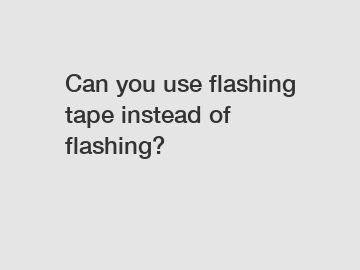Can you use flashing tape instead of flashing?
Flashing tape vs Flashing: Which Should You Use?
When it comes to protecting our homes from the elements, flashing plays a crucial role. Flashing is a thin material that is installed around openings in a building, such as windows, doors, and vents, to prevent water from seeping in and causing damage. Traditionally, metal flashing has been the go-to material for this purpose. However, in recent years, flashing tape has emerged as an alternative to traditional metal flashing. But can you use flashing tape instead of flashing? Let's explore the differences between the two and determine which is the better option for your next project.
Flashing Tape: A Modern Alternative.

Flashing tape is a self-adhesive, waterproof tape that is made from materials like rubberized asphalt or butyl. It is designed to provide a seal against moisture and is commonly used in conjunction with other building materials to create a watertight barrier. Unlike metal flashing, flashing tape is flexible and easy to install, making it a popular choice among DIY enthusiasts and contractors alike.
Benefits of Flashing Tape.
One of the main benefits of flashing tape is its ease of installation. Unlike metal flashing, which requires special tools and expertise to install correctly, flashing tape can be applied quickly and easily by anyone with basic DIY skills. Additionally, flashing tape is more forgiving than metal flashing when it comes to irregular shapes and angles, making it a versatile option for a variety of applications. Finally, flashing tape is resistant to UV rays and will not deteriorate over time like some metal flashings can.
Metal Flashing: A Time-Tested Solution.
While flashing tape has its advantages, metal flashing has a long history of use in the construction industry for a reason. Metal flashing is durable, fire-resistant, and can last for decades when installed correctly. Metal flashing is also better at withstanding extreme temperatures and can be painted to match the aesthetics of a building. In some cases, such as in areas with high winds or heavy rainfall, metal flashing may offer better protection against moisture intrusion than flashing tape.
Choosing the Right Material.
When deciding between flashing tape and metal flashing, it's essential to consider the specific needs of your project. If you are looking for a cost-effective, easy-to-install solution for a DIY project, flashing tape may be the way to go. However, if you need a long-lasting, durable option for a high-risk area of your home, metal flashing may be the better choice. Ultimately, the decision between flashing tape and metal flashing will come down to your budget, your level of expertise, and the requirements of your project.
Conclusion.
In conclusion, both flashing tape and metal flashing have their advantages and drawbacks. Flashing tape is a modern, convenient alternative to traditional metal flashing, but it may not be suitable for all applications. When deciding between flashing tape and metal flashing, it's important to consider factors such as cost, durability, and ease of installation. If you are unsure which option is right for you, consult with a professional contractor who can help you make an informed decision.
If you have any questions about flashing tape or metal flashing, please feel free to contact us. We are here to help!
For more information, please visit Polypropylene Geotextile Bitumen Cold Applied Tape, 3-ply Butyl Rubber Pipieline Inner Tape, butyl rubber anti corrosion tape.

Comments
0